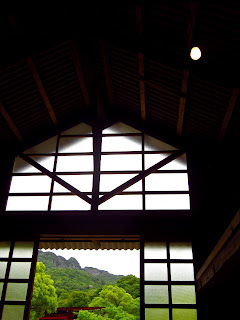- Yone Noguchi (1875 - 1947)
poet and father of sculptor Isamu Noguchi
A walk into the hills and down a country road. There is a bend created by a wall of rocks. This is not an ordinary stone fence demarcating farms or the villas of aristocrats. This wall is made up of discarded stone sculpture, thousands of practice pieces that literally didn't make the cut. Nature and time have slowly overtaken these would-be works of art.
This is the approach to the Isamu Noguchi Garden Museum.
In the spring of 1969 Japanese-American artist Isamu Noguchi established his studio in Mure-cho in Kagawa Prefecture. He spent about half of each year here working until his death in 1988. The other 6 months were spent at his studio in Queens, New York. Noguchi came to this region for the stone, but beyond this practical reason it is easy to see why he was inspired to work here, the wide open space, the beautiful rugged terrain, the Seto Inland Sea off in the distance.
His original studio is a dream - a large, wooden minka (farmhouse), earthen floors, light pouring in from the high gable windows. The boundaries of inside and outside blurred by the giant sliding doors. It just feels like art. What else could happen within these walls?
It is always interesting for me to see the work space of an artist. Noguchi's tools - hammers, chisels, hand-held power tools, wenches and enormous saws with blades like the sun - are all as he left them. Decades of dust and rust cover them softly. A sort of beautiful melancholy. Wabi-sabi.
The sculpture garden is a place to contemplate Noguchi's work for hours, days, a life time. I am disappointed by the imposed time constraint. The Noguchi Museum in Queens is better suited for long conversations with his art. This lovely, semi-rural location asks us to slow down and let the pieces speak. To rush through is almost criminal.
There is something very welcoming and familiar about this place. I don't want to leave.




